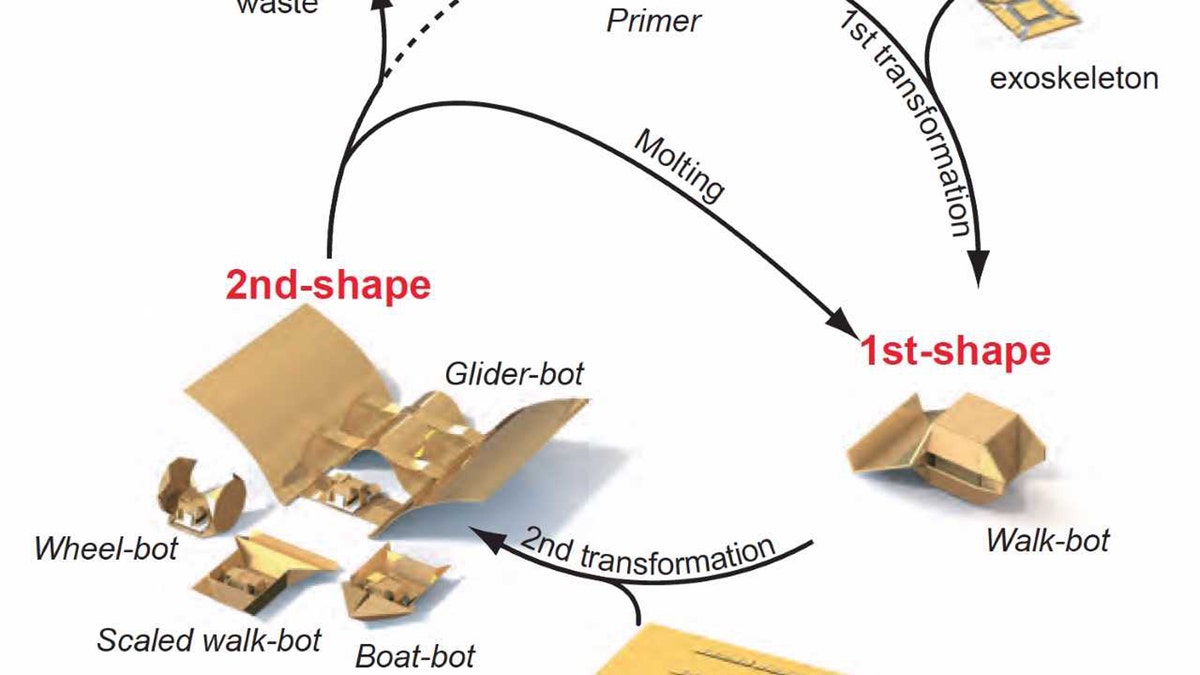
This tiny robot can transform, thanks to a special exoskeleton outfit. (Credit: Jason Dorfman, MIT CSAIL)
Thanks to special exoskeleton outfits, a tiny transforming robot can now become more than meets the eye. Once outfitted with the plastic exoskeletons, the small bots– dubbed Primers– are able to swim, walk, roll, sail and glide.
Created by researchers at the Massachusetts Institute of Technology’s Computer Science and Artificial Intelligence Laboratory (CSAIL), the Primer bot is a magnetic cube only a few centimeters in size that can be remote controlled using magnetic fields. Via remote control, this micro machine is able to move across surfaces before picking up one of four exoskeletons, each made from a plastic sheet. When heated, these sheets fold around the bot into predetermined shapes that enable Primer to become a tiny boat or hang–glider, the latter allowing it to fly through the air when falling.
Researchers at CSAIL created the exoskeletons to get around some of the hurdles faced in creating transforming robots.
GET SET FOR SEX ROBOT REVOLUTION, SURVEY SAYS
“It is difficult to build robots that can change their form or function at a very fine resolution - so-called ‘cellular machines’ are still far too coarse to be very useful,” CSAIL director Dr. Daniela Rus told Fox News. “The advantage of these exoskeletons is that the bodies are very precisely tuned for each particular task.”
Her team created the new bot by combining two of their creations: the cube-shaped robot that can assemble itself into different configurations, and the small origami robots that can be customized to fold into specific shapes from sheets of plastic.
“Combining these two approaches, we’ve been able to develop a basic robot body with fine-tuned ‘super-suits’ (exoskeletons) that it can pick up and drop off for different tasks,” Rus added.
She hopes that the tiny robots could one day be used for multi–phase surgery. “We’ve previously developed an origami robot that can be swallowed, with the idea that it could be used to do medical procedures inside your stomach,” she explained. “With this new approach, you could imagine being able to swallow a basic cube robot to do one task - deliver a drug, for example - and then swallow additional robots that can be magnetically controlled to combine with the robot to do other things, like patch wounds or perform simple surgeries.”
The exoskeleton technology could also be used in larger applications. For instance, a smaller robotic car could be built that would be able to squeeze into small spaces, along with an exoskeleton to fit around it and hold a few bikes.
ROBOTS COULD OVERPOWER HUMANS THANKS TO NEW 'ARTIFICIAL MUSCLE'
“It’s exciting to think that a robot could serve as a ‘Swiss army knife’ that could be used for a range of tasks depending on the different accessories it has,” Rus explained. “This is a research prototype, so there are no immediate plans to commercialize, but we certainly would encourage other researchers to build on our designs and explore the possibility of bringing these sorts of systems to the marketplace.”
Rus and her team are currently working to make robots with exoskeletons at different scales to support larger applications, such as the aforementioned car–sized model. They are also working on the “mini–surgeon” bot capable of incision–free surgery, which could potentially use different types of biomaterials so that it can do more long-term operations.




















